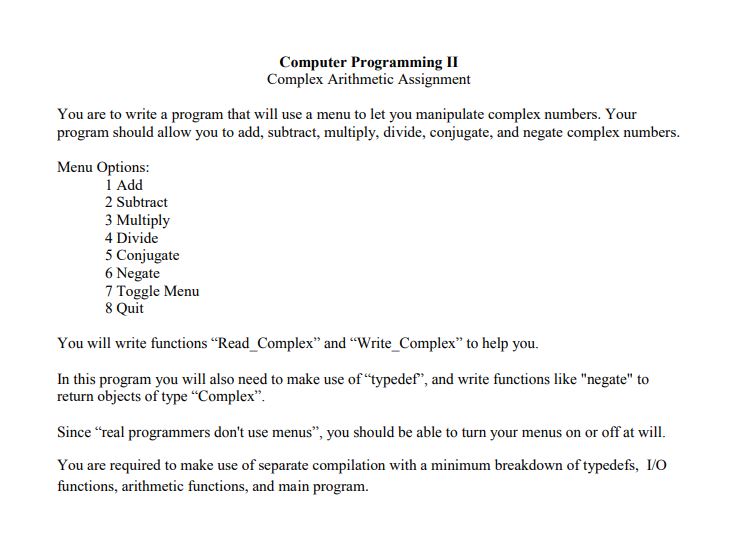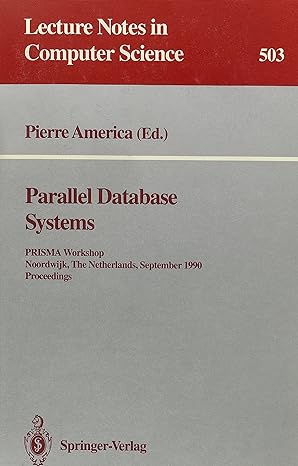Answered step by step
Verified Expert Solution
Question
1 Approved Answer
You are to write a program that will use a menu to let you manipulate complex numbers. Your Complex Arithmetic Defining a new type for
You are to write a program that will use a menu to let you manipulate complex numbers. Your Complex Arithmetic
Defining a new type for a complex number consisting of two parts, real and img, both of which will contain integers:
Declaring variables of this type:
complex num;
Accessing variables of this type:
printfEnter the real part of the number: ;
scanfd &num.real;
printfEnter the imaginary part of the number: ;
scanfd &num.img;
Note: The member notation is a PERIOD indicating which member of the structure you are referring to
Files and subprograms needed for this activity:
main.c
The main program will consist of a menu driven program that provides the user with a menu to
manipulate complex numbers. The menu options will include add, subtract, multiply, divide, conjugate,
negate, toggle menu, and quit.
The switch statement will have a case for each menu option and will make use of a variety of
subprograms to perform the necessary actions associated with the menu option selected.
Example:
complex.h
Will contain the type definition for the complex type
boolean.h
Will contain the #define statements for TRUE and FALSE as well as the type definition for the boolean
type
ComplexIO
Note: Will need ComplexIOh for prototypes and ComplexIOc for definitions
ReadComplex will prompt for input of the real and imaginary part of a number and then return the
complex number to the main program where it will be assigned to the appropriate variable.
WriteComplex will take a single complex number sent to it and display it in the standard format
where is the real part and is the imaginary part.
Note: If the imaginary part is negative, then this should appear as i and not
ComplexArith
Note: Will need ComplexArith.h for prototypes and ComplexArith.c for definitions
AddComplex will take two complex numbers passed to it calculate the sum, and then return the
complex answer.
SubtractComplex will take two complex numbers passed to it calculate the difference and
then return the complex answer.
MultiplyComplex will take two complex numbers passed to it calculate the product, and then return
the complex answer.
DivideComplex will take two complex numbers passed to it divide by the and then print the
answer locally because it will not be able to be assigned to our complex type because the parts will be
real numbers and not integers.
Note: Need to prevent division by zero in the main program before calling subprogram.
ConjugateComplex will take a single complex number sent to it multiply the imaginary part only by
negative one, and return the resulting complex number.
NegateComplex will take a single complex number sent to it multiply both the real and the imaginary
parts by negative one, and return the resulting complex number.
program should allow you to add, subtract, multiply, divide, conjugate, and negate complex numbers.
Menu Options:
Add
Subtract
Multiply
Divide
Conjugate
Negate
Toggle Menu
Quit
You will write functions "ReadComplex" and "WriteComplex" to help you.
In this program you will also need to make use of "typedef", and write functions like "negate" to
return objects of type "Complex".
Since "real programmers don't use menus", you should be able to turn your menus on or off at will.
You are required to make use of separate compilation with a minimum breakdown of typedefs, IO
functions, arithmetic functions, and main program.

Step by Step Solution
There are 3 Steps involved in it
Step: 1

Get Instant Access to Expert-Tailored Solutions
See step-by-step solutions with expert insights and AI powered tools for academic success
Step: 2

Step: 3

Ace Your Homework with AI
Get the answers you need in no time with our AI-driven, step-by-step assistance
Get Started


